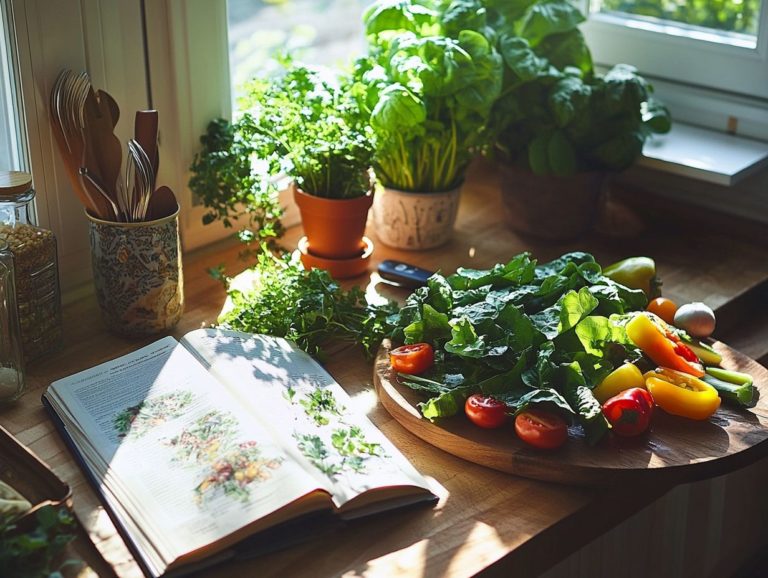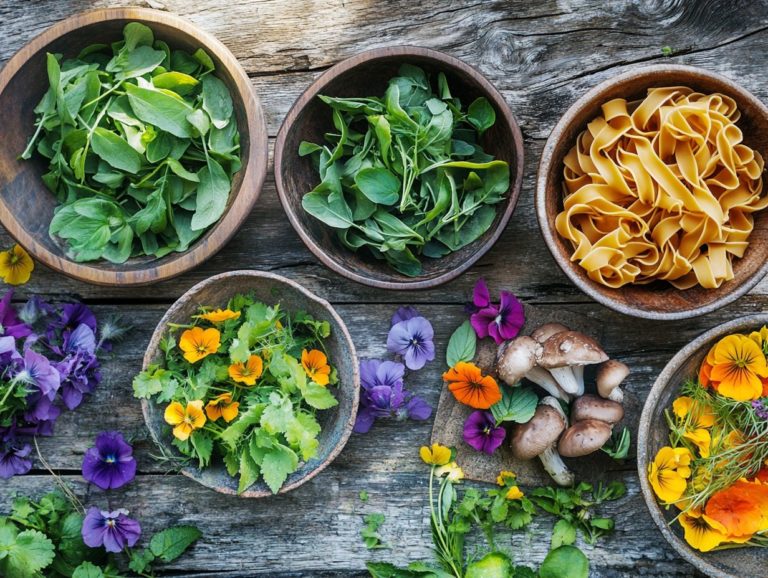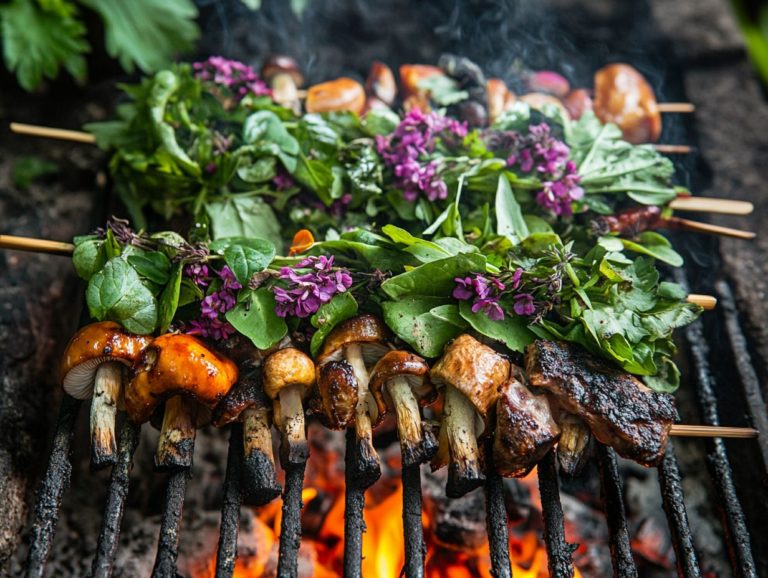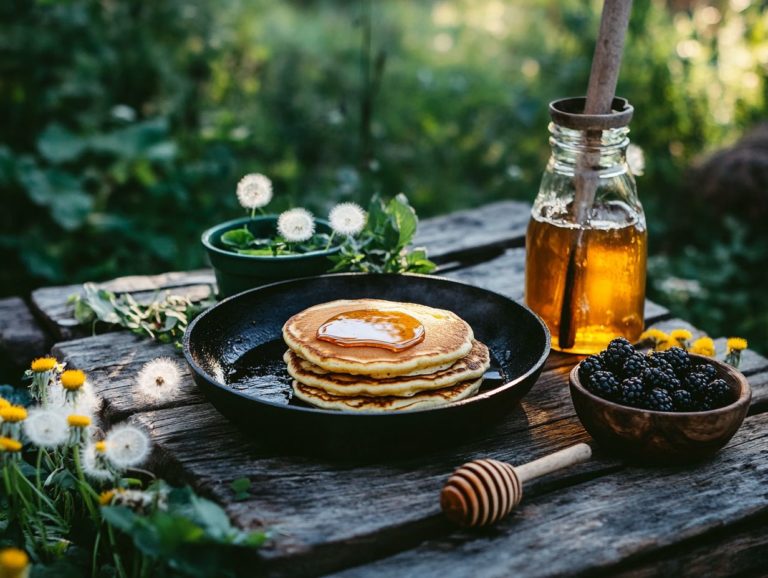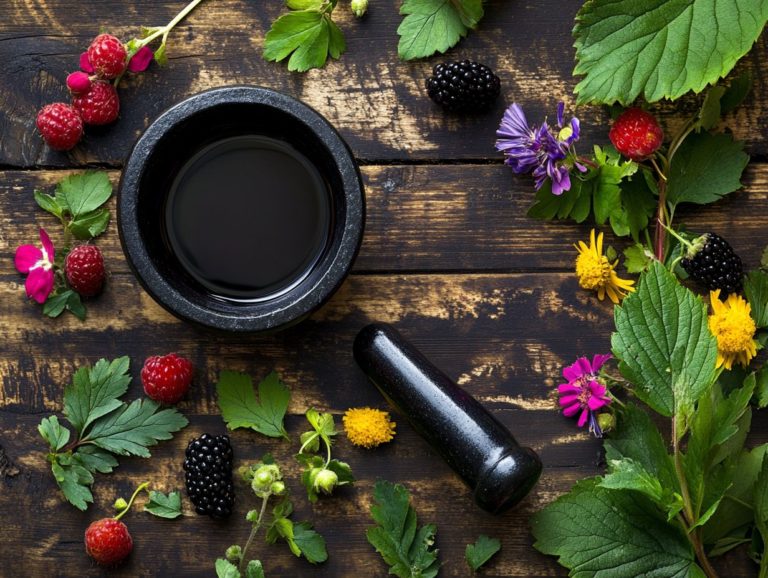Exploring Unique Wild Edible Recipes
Wild edibles present a delightful and nutritious opportunity to enrich your diet while fostering a deeper connection with nature through foraging for unique ingredients.
Imagine foraging in local parks, transforming your culinary creations at home with wild food and unique, natural ingredients that infuse excitement into every meal.
Uncover the nutritional advantages of wild edibles, learn where to locate them, and familiarize yourself with essential safety tips. Explore a curated collection of enticing wild mushroom recipes and other unique recipes waiting to be tried.
Join us on an exciting cooking journey with Hank Shaw’s recipes and elevate your dining experience with the vibrant flavors of the wild!
Contents
Key Takeaways:

- Discover the nutritional and health benefits of incorporating wild edibles, including edible plants like dandelion and chickweed, into your diet, such as increased vitamins and minerals.
- Learn how to safely forage for unique wild edibles and where to find them in your local environment, enhancing your cooking skills and methods.
- Get creative in the kitchen with our unique wild edible recipes like venison steak and salmon piccata, adding a delicious and nutritious twist to your meals.
What are Wild Edibles?
Wild edibles represent a captivating array of edible plants, herbs, and mushrooms that you can forage directly from nature. These unique ingredients not only elevate your home cooking and comfort food but also invite you on a cooking journey that includes gathering food from nature and exploring its distinct flavors and nutritional benefits.
Engaging with wild food through foraging provides a deeper connection to your environment, all while supporting sustainable food practices that enhance healthy eating.
If you’re looking to diversify your diet with wild ingredients, understanding what constitutes wild edibles is your first step on this flavorful journey of culinary exploration.
Many people are rediscovering the rich bounty of wild edibles, including familiar yet often overlooked plants like dandelion, stinging nettle, and wild herbs. Dandelions, with their peppery greens and vibrant blooms, are not just a culinary delight; they’re also brimming with vitamins and antioxidants, easily incorporated into salads or brewed in teas, making them a perfect addition to recipes for healthy eating.
Stinging nettle, often avoided due to its prickly reputation, transforms into a nutrient-rich gem once cooked. It makes for a fantastic addition to soups and pesto or even unique wild cocktails, packed with health benefits like anti-inflammatory properties.
By foraging these plants, you can contribute to a healthier planet while enriching your meals with seasonal, organic produce that supports sustainable food practices.
Benefits of Incorporating Wild Edibles in Your Diet
Incorporating wild edibles into your diet presents a wealth of health benefits, such as unique flavors and simple recipes, making it a truly rewarding culinary journey.
These ingredients rich in nutrients, sustainably sourced through foraging, are packed with vitamins, minerals, and antioxidants that support your overall well-being. They are perfect for cooking methods that make food taste better.
The unique flavors they add to your recipes can transform ordinary meals into gourmet experiences, like pasta primavera, fostering a deeper appreciation for seasonal ingredients and the rich diversity of nature s bounty.
By embracing wild food, you not only refine your culinary skills but also make a significant impact on your health and the environment, promoting sustainable food practices and healthy eating.
Start foraging today or try one of our featured recipes to experience the vibrant flavors of wild edibles!
Nutritional Value and Health Benefits
The nutritional value of wild edibles is truly remarkable. They often outshine cultivated greens, making them a treasure trove for health-conscious individuals, especially those who enjoy foraging. Edible plants such as chickweed and stinging nettle are brimming with vitamins A and C, alongside essential minerals and antioxidants. These nutrients can bolster your immune system, making them perfect for simple recipes and unique flavors.
Incorporating these wild ingredients into your meals elevates flavor profiles and adds vibrancy to your diet. Celebrate the seasonal bounty with dishes like wild mushroom risotto that nature provides.
Take wild rice, for example. It serves as a nutritious base for a hearty hotdish, rich in fiber and protein. This promotes digestive health and keeps you feeling full, especially when served with seasonal food. Meanwhile, elderflowers can be transformed into delightful fritters, delivering a unique taste along with anti-inflammatory properties that support your overall wellness.
Exploring these wild edibles allows you to embark on delightful culinary adventures. They nourish both body and spirit, illustrating the profound connection between natural ingredients and overall health benefits through unique recipes.
Foraging for Wild Edibles
Foraging for wild edibles is not just an activity; it s an enriching journey. It deepens your connection with nature while granting you access to unique ingredients like wild herbs and mushrooms often overlooked in grocery stores.
Knowing where to find these treasures and how to identify them is key. Cooking classes and detailed guides can help you forage safely. Whether you’re wandering through a park or exploring a forest, recognizing plants like burdock, American basswood, or Japanese knotweed can uncover tasty finds. Always prioritize safety by ensuring proper identification and being aware of local regulations regarding wild crafting.
Refining your foraging skills, including cooking methods, opens the door to delightful flavors and sustainable practices.
Where to Find Wild Edibles
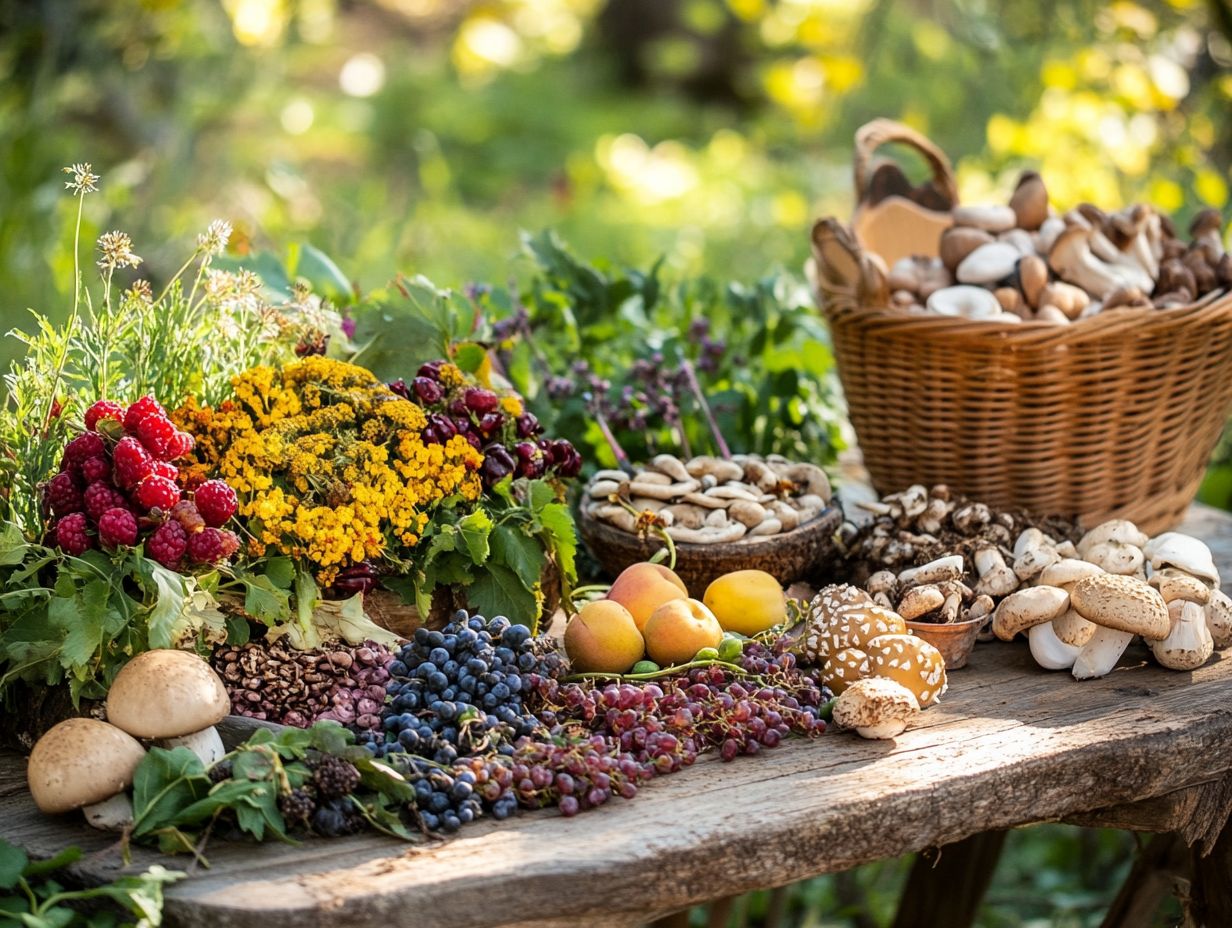
Discovering wild edibles is an exciting adventure into local ecosystems! These hidden gems often flourish in forests, fields, and even urban gardens, making for thrilling culinary exploration. Many edible plants thrive in specific environments. For instance, dandelions bask in sunny spots, while stinging nettles often linger near water sources, creating opportunities for simple recipes.
By familiarizing yourself with the habitats of common wild edibles, including wild herbs, you significantly boost your chances of a successful foraging expedition. Engage with your surroundings and learn to identify wild herbs and plants. This enriches your cooking skills and cultivates a deeper connection with nature.
Take forests, for example. They are brimming with options like mushrooms, berries, and wild greens that can elevate your meals with freshness, allowing for gourmet cooking experiences. Meadows beckon with clover and chicory, each bringing its own culinary charm. This is perfect for simple recipes that celebrate flavor combinations. In contrast, wetlands offer a unique ecosystem where plants like cattails and watercress thrive, contributing to seasonal food choices.
If you’re keen on foraging, consider utilizing detailed guides or smartphone apps that provide images and descriptions. This is perfect for learning cooking methods to identify these edible wonders with confidence. Connecting with local foraging groups can further enrich your experience in wild crafting, as you share insights and knowledge about specific plants and their safe collection.
Start your foraging journey today! Grab a guide and explore your local parks.
Safety Precautions and Guidelines
Safety precautions are essential when you re foraging for wild edibles. They ensure your cooking experience remains both rewarding and risk-free by using practices that help keep nature healthy. First and foremost, accurate identification of wild plants is crucial, as some may closely resemble toxic varieties, particularly those that are unsafe for cooking methods. Relying on trusted field guides or food blogs can significantly assist you in this endeavor, enhancing your cooking skills.
Consider attending local workshops or guided excursions focused on plant identification, culinary exploration, and foraging techniques. These experiences will not only enhance your knowledge of wild food recipes but also boost your confidence in the field.
Understanding the seasonal variations in plant growth is equally important, as certain plants may be safe to consume only during specific times of the year. This knowledge informs your cooking techniques.
Beyond just identification, adopting sustainable foraging practices such as harvesting only a small percentage of wild plants helps preserve the environment and ensures these resources are available for future foragers.
Respecting local laws and guidelines helps create community care and responsibility, enriching your overall foraging experience and promoting healthy eating habits.
Unique Wild Edible Recipes
Exploring the realm of wild edibles unveils a treasure trove of exceptional recipes that celebrate nature’s flavors, including Hank Shaw’s signature dishes, while also showing you how to cook with foraged edibles to elevate your culinary skills.
Imagine crafting delightful elderflower fritters or indulging in hearty wild mushroom risotto. These dishes showcase unique flavor combinations that reflect your cooking experience. They highlight the benefits of foraged ingredients and beckon you to embark on a culinary journey that embodies seasonal and sustainable food practices.
By integrating wild ingredients into your meals, you can transform comfort food into something extraordinary and health-conscious, tantalizing your palate with unique flavor combinations.
Recipe 1: Elderflower Fritters
Elderflower fritters are a delightful treat that capture the essence of spring in every bite. Picture delicate elderflower blooms, lovingly coated in a light batter and fried to a perfect golden brown. They serve as a sweet dessert or snack. The result? A sweet and crispy exterior that begs for a dusting of powdered sugar, creating a delightful end to your foraging culinary journey. These fritters not only celebrate wild edibles but also make for an exquisite dessert or snack, truly a must-try for anyone passionate about foraging and wild ingredients.
Foraging for elderflowers is nothing short of enchanting. It allows you to experience nature cooking firsthand. As these blossoms bloom in late spring, you find the perfect opportunity to gather ingredients while reconnecting with nature and practicing your cooking skills. The process invites you to identify elder trees, often found in hedgerows and open fields, and select the freshest clusters of flowers, ensuring the best flavors for your wild edible recipes. With their fragrant, honey-like aroma, these elderflowers are bursting with flavor, elegantly enhancing your fritters and bringing a taste of the wild right into your kitchen.
To whip up this enticing dish of elderflower fritters, you ll need:
- A sturdy handful of fresh elderflower blossoms.
- Flour for the light batter.
- Sugar for sweetness.
- Baking powder to give your fritters the perfect rise.
- Sparkling water for a light and airy texture.
- A pinch of salt to enhance the flavors of your dish.
Let s dive into the cooking instructions to create this seasonal delight. Try making these fritters at home and enjoy a taste of spring!
Recipe 2: Wild Mushroom Risotto
Wild mushroom risotto is a comforting dish that showcases the unique flavors and textures of foraged mushrooms, creating a rich and creamy experience for your palate.
By combining a medley of wild mushrooms, like garlic-roasted varieties, with arborio rice (a type of short-grain rice that makes risotto creamy), you bring the earthy essence of nature together with the satisfaction of comfort food.
A finishing touch of parmesan and fresh herbs elevates this dish, making it a standout centerpiece for any dinner table. This recipe is perfect for those looking to expand their repertoire of unique recipes.
To embark on this cooking experience, it s essential for you to choose fresh wild mushrooms, ranging from the delicate chanterelles to the robust porcini.
Each offers distinct flavors that enhance the overall profile of your risotto. When preparing your wild mushrooms, gently wash and thoroughly dry them to remove any dirt, allowing their natural flavors to shine through.
As you saut these mushrooms, their enticing aromas will fill your kitchen, creating an inviting cooking atmosphere, reminiscent of nature cooking.
Add a splash of white wine and a ladle of warm vegetable broth as the rice cooks, and you ll create a creamy texture that beautifully marries all the ingredients.
This dish celebrates the bounty of nature and provides a warm, inviting meal that brings your loved ones together, making it a fantastic choice for simple recipes.
Recipe 3: Salmon Piccata with Wild Herbs
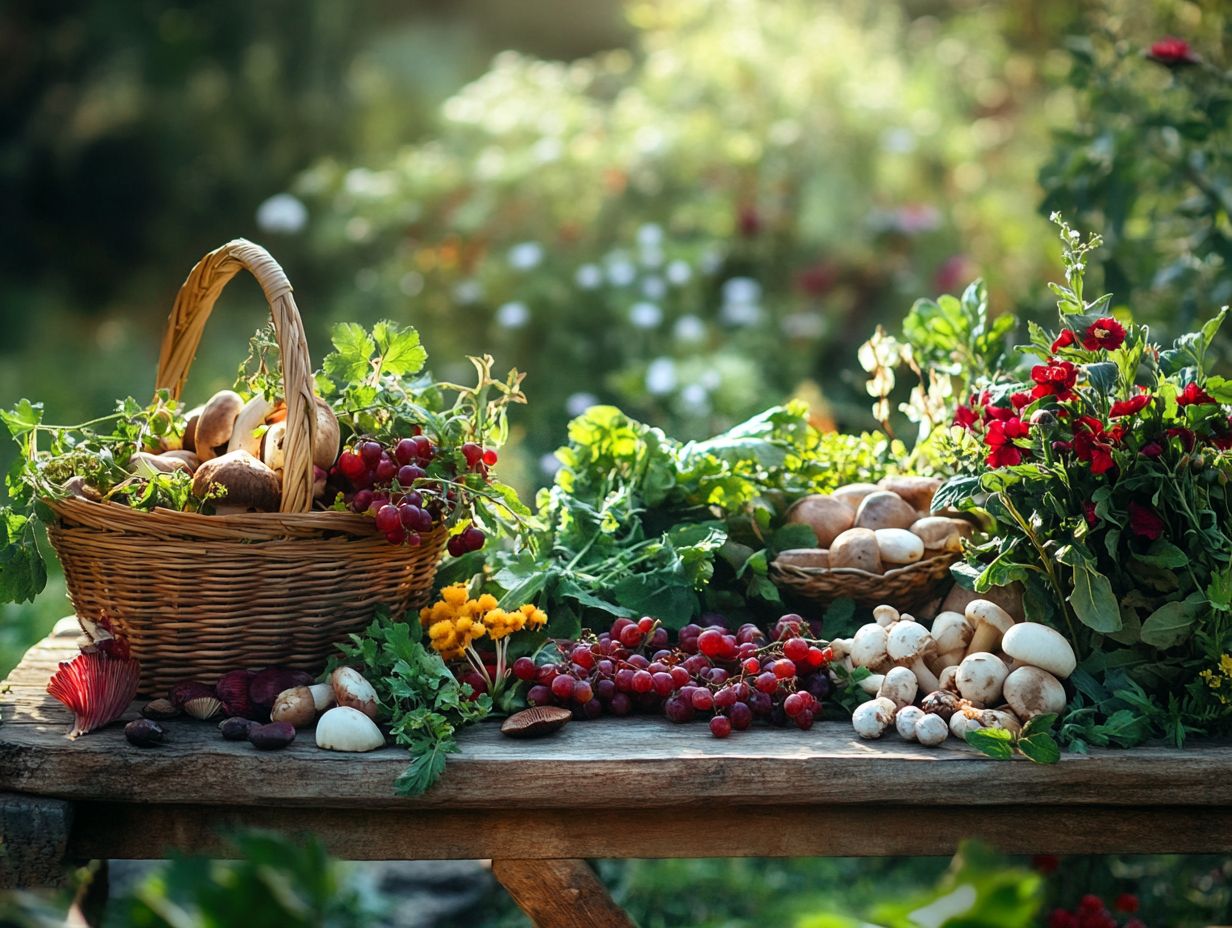
Salmon piccata, infused with a medley of wild herbs, presents an exquisite twist on a classic dish, bringing forth the vibrant flavors of nature.
By incorporating herbs like burdock and stinging nettle into the traditional lemon-butter sauce, you elevate the taste of the salmon while celebrating the bounty of foraged ingredients.
The steps are simple and quick, making it an ideal choice for those seeking a culinary adventure without the fuss. This recipe also pairs beautifully with smoked salmon.
This delightful dish not only tantalizes your taste buds but also introduces the nutritional benefits of wild herbs, which have graced tables across cultures for centuries.
The unique flavors of burdock lend a subtle earthiness, while stinging nettle adds a refreshing green note that beautifully complements the richness of the salmon.
For those who may be unfamiliar with these herbs, they offer a treasure trove of vitamins and minerals, enhancing the healthfulness of your meal and encouraging healthy eating.
Follow these straightforward steps to prepare salmon piccata, ensuring each bite bursts with flavor and nutrition. It s perfect for any dinner table, exemplifying the art of gourmet cooking.
Tips for Cooking with Wild Edibles
Cooking with wild edibles invites you into a realm of unique techniques and insights, including wild edible pizza toppings, that allow you to fully appreciate their rich flavors and nutritional benefits.
By mastering the art of preparing these ingredients, you can elevate ordinary meals into gourmet masterpieces that reflect the rustic elegance of nature.
Embrace the opportunity to experiment with unique flavors through wild crafting.
Envision simple yet captivating cooking methods, like grilling fish over an open flame or crafting a vibrant pasta primavera with foraged vegetables.
These approaches showcase the wild ingredients at their finest and transform your kitchen into a stage for a delightful culinary adventure, echoing the fresh essence of seasonal food.
Don t miss out on this flavor-packed experience! Try these recipes today and bring nature s flavors to your table!
Preparing and Cooking Techniques
Mastering the preparation and cooking techniques for wild ingredients can elevate your cooking skills, allowing you to truly savor their distinctive flavors. Techniques like blanching wild greens, such as chickweed, and saut ing wild mushrooms preserve their freshness and vivid colors. Experimenting with ingredient substitutions using wild herbs instead of regular spices can uncover delightful surprises in your home cooking.
Cleaning wild edibles thoroughly is crucial to eliminate any dirt or unwanted residues. Rinsing greens under cold water or using a gentle brush effectively prepares them for your culinary creations, making food preservation easier.
When it comes to cooking, roasting wild root vegetables, like burdock or dandelion, enhances their natural sweetness. Pair them with earthy flavors like garlic or thyme to elevate your dish. These techniques can be applied to various wild plants, creating exceptional mushroom recipes.
Embrace the chance to incorporate these unique ingredients into soups, sauces, or salads. Their flavors can add a refreshing twist to familiar recipes, and you might even want to try making wild edible pancakes, transforming each meal into a memorable experience that reflects the essence of foraging.
Final Thoughts and Recommendations
Dive into this exciting journey and discover a treasure trove of flavors! Embarking on a culinary adventure with wild food can truly elevate your cooking experience and encourage healthier eating habits. To get started, explore the most popular foraging recipes, which incorporate wild edibles into your meals. This opens up a world of flavor and nutritional benefits while fostering a deeper connection with nature.
As you explore foraging, it s vital to prioritize safety and sustainability. This ensures that your culinary explorations are both rewarding and responsible, allowing for the exploration of DIY recipes.
A more varied diet provides essential nutrients that store-bought ingredients might lack, enhancing both your meals and overall well-being. Foraging transcends mere gathering; it s about respecting the environment and practicing sustainable harvesting methods to preserve biodiversity, which is essential for sustainable food.
If you’re intrigued by this path, consider researching local wild food options and perhaps even joining community foraging groups. Ultimately, the benefits of wild edibles extend beyond taste; they cultivate a profound appreciation for our natural surroundings and promote a healthier lifestyle, encouraging you to explore various recipes that highlight these unique ingredients.
Frequently Asked Questions
What are wild edibles?
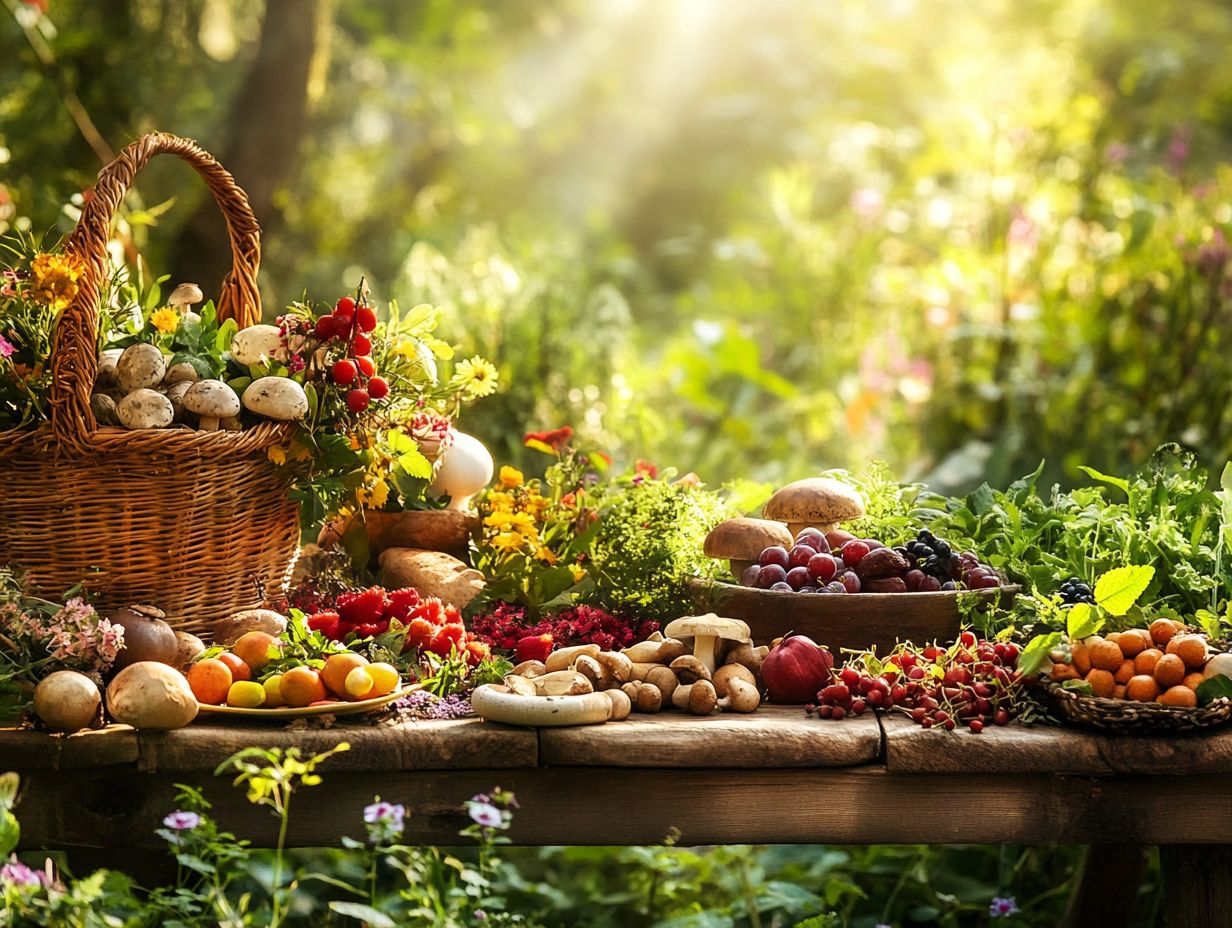
Wild edibles are plants or fungi that grow naturally in the wild and are safe to eat. They are often used in cooking to add unique flavor and nutritional value to meals, making them a great choice for those interested in exploring wild crafting.
Why should I explore unique wild edible recipes?
Exploring unique wild edible recipes allows you to discover new flavors and incorporate more nutritional diversity into your diet, such as using wild edibles for creative sauces, enhancing your culinary exploration.
How can I find wild edibles?
Wild edibles can be found in forests, fields, and even urban areas. It’s important to properly identify the plants before consuming them to ensure they are safe to eat, an essential skill in wild crafting.
Are there any risks associated with eating wild edibles?
While most wild edibles are safe to eat, there is always a risk of misidentification. Consulting a reputable source or expert before consuming any wild plants is crucial, especially when trying unique recipes.
What are some popular wild edibles used in recipes?
Some popular wild edibles include ramps, morel mushrooms, dandelion greens, and elderberries. They offer a diverse range of unique flavors and textures to dishes, particularly in mushroom recipes.
Are there any safety precautions I should take when foraging for wild edibles?
Yes, it’s important to wear appropriate clothing and use caution when foraging for wild edibles. Avoid areas that may have been contaminated with pesticides or other chemicals to ensure a safe experience in your culinary adventure.

